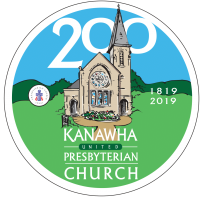
The first settlement of the Charleston area, at the junction of the Elk and Kanawha rivers in southern West Virginia (then Virginia), took place in 1787, and by 1810 the population had increased to 100 persons. The area’s first Presbyterian minister, Reverend Henry Ruffner, began his work in 1815, and his son furthered his efforts to the extent that David Ruffner has been called “The Father of Presbyterianism in the Kanawha Valley.” On March 14, 1819, the Presbyterian Church was formally organized with about 18 members. The name given to this organization was “Kanawha Presbyterian Church.” By this time Charleston’s population was about 500.
The first pastor was Dr. Calvin Chaddock, who delivered his first sermon in the little upper room of Mercer Academy on August 1, 1819. In “The Ark,” an oak chest containing relics of the church, rests a yellowed bundle of Dr. Chaddock’ s sermons, in his own handwriting, the earliest of which bears the date of that first sermon. Dr. Chaddock died in 1823.
The Reverend Nathaniel Calhoun assumed the pastorate in 1826, and in 1828 organized the first Sabbath School (though greatly opposed, states the record. The small congregation, about 20 members, determined that they should build a house of worship of their own, and in spite of their small numbers did erect “the old brick church,” which was dedicated November 20, 1830. The congregation worshiped there for 42 years, until June 1872. When the church burned to its bare walls during the winter of 1845-6, an interested party collected from the crowd watching the conflagration almost enough money to rebuild the church.
Dr. James Moore Brown served as pastor from 1837 until his death in 1862. When the Civil War began in 1861, Dr. Brown stood against allowing politics to divide the church, recommending adherence to the General Assembly. When West Virginia became a state and part of the Union, public sentiment was divided in the Kanawha Valley as to allegiance to the Union or the Confederacy, and hence to the General Assembly or to the new Southern Assembly. The session decided to send delegates to neither Presbytery, trusting that with the passage of time the differences of opinion would cease to exist. For eleven years the church maintained no allegiance to either, but pressures from outside the congregation forced a resolution, and Kanawha Church chose to remain with the “northern” church. The southern faction retained the brick church building, so the small congregation worshiped first in the Senate Chamber of the State Capitol and then in Asbury Chapel, recently vacated by the Methodists and purchased and repaired by three members of Kanawha Church, who offered it to the church without rental. Undaunted by their small numbers, the congregation began immediately to plan the building of a new edifice. The cornerstone of the beautiful building in which the congregation now worships was laid on April 20, 1873.
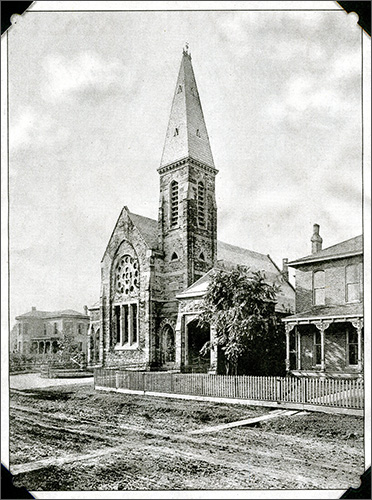
The ground was excavated and the foundation laid when an economic panic struck and all enterprise in the community was halted. The foundation stood with its basement window frames partly up, and in the winter children skated on the “ice rink” which formed from the standing water in the basement. In the eight years since the division of the congregation, the number of members had dwindled to sixteen, but by 1880 the determined few had raised the walls but were unable to finance the desperately-needed roof, at $2,000. In 1883 the Board of Church Erection came through with a grant which funded the roof. After more years of work and sacrifice, the completed building, twelve years under construction, was dedicated on April 25, 1885.
During the next eight years, under the leadership of Dr. Torrence, almost 200 members were added to the roles, and a Sunday School and lecture room were added at the rear of the church. It was during Dr. Torrence’s ministry that Kanawha Church established three mission churches, one of which was Schwamb Memorial Chapel, later to become the source of the “United” in Kanawha United Presbyterian Church.
Under the direction of Dr. John Waddell, pastor from 1907 to 1913, the city’s Union Mission was organized. In 1915, during the pastorate of Dr. Albert Evans (1913-1924), the people of the church engaged the Tiffany Studios in New York to design and install the rose and lancet windows in the rear of the sanctuary and four lancet windows in the west side of the church. These priceless treasures, inspirational to behold and some of the finest ecclesiastical art in America, attest to the vision, faith, and enthusiasm of the congregation of 1915.
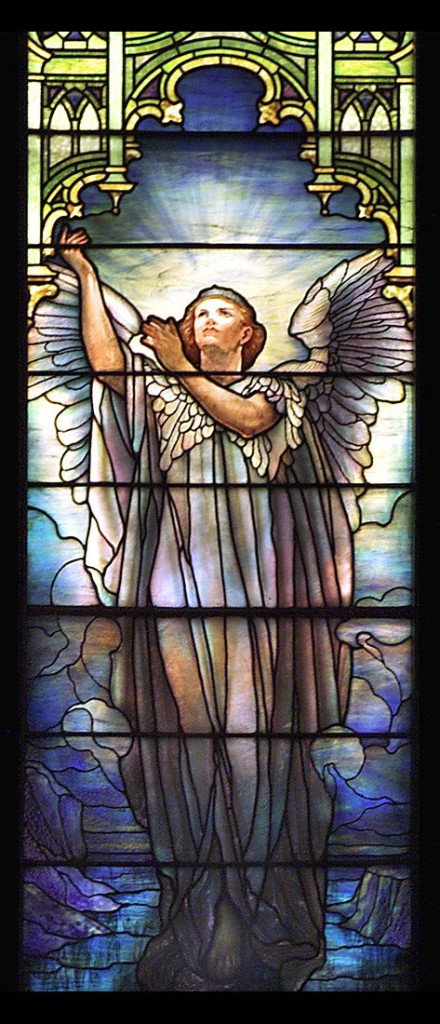
The expanding of industry in the Kanawha Valley after World War I and World War II brought many new people into the region and many new members into Kanawha Church. During the long tenure of Dr. Warren Stone, 1926-1943, many forward steps were made in and for Kanawha Church and its concerns. In 1930 a Loyalty Crusade was carried out, and a complete and detailed history of the church was compiled, at request of Session, by Miss Jean Brown. In 1939 Session was reorganized, replacing life membership with a rotation system, limiting service. Interest in the church’s missions, the music of the church, and Sunday School reached new levels. In 1943 Dr. Stone was succeeded by Dr. Curtis Jones. During his years of service the budget increased 30%, and the church exceeded its quota in the Wartime Service fund. The grant of $2,000 made by the Board of Church Erection in 1883 for the church roof was refunded to be used elsewhere. The church organ was rebuilt and a building fund was established: the pledge to the Benevolent Fund of the Church at Large was increased.
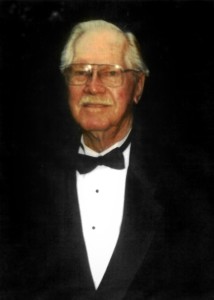
Dr. Bernard Vanderbeek came to Kanawha Church in 1949 and became an active leader in both church and community. A study for the long- range growth of the church resulted in the decision to take down the old manse, built in 1829 and purchased in 1845. Plans for rebuilding and expanding the educational unit were submitted in 1951, and groundbreaking ceremonies took place in November, 1953. Plantings beautified the front of the church, the courtyard, and the parking lot. Members of all ages participated in cleaning, painting, sanding, flooring, and refinishing, and the spirit of cooperation blossomed. Classes and meetings were “farmed out” all over Charleston while the work was in progress. Dedication of the new building took place in October, 1954.
In 1961 it was determined that the old organ could no longer be repaired, and an Allen electronic organ was dedicated in 1962. Renovations to the chancel, refurbishing of the vestibules, and the purchase of new hymnbooks preceded the dedication of the new instrument.
Also in 1962 Reverend and Mrs. Jackson participated in the Fil-American Team of Testimony, a mission to the Philippines, where they worked with native groups to build a church and organize it, and participated in training sessions with nearby communities. In 1965 Alex Giltinan represented the church on a missions trip to Colombia.
In 1966 Dr. Bernard Vanderbeek returned to the pastorate of Kanawha for another eight years, and the day of his installation also saw the dedication of the eight stained glass windows designed by the Willet Studios of Philadelphia. These colorful windows tell the story of the life and work of Christ and include scenes from the Old Testament and vignettes of leaders of the church throughout its history, among them St. Augustine, Martin Luther, John Knox, Albert Schweitzer, Dr. Livingstone, and figures from Kanawha’s own history.
In 1969 Kanawha celebrated its 150 years of history and worship with dinners, music, joint meetings with First Presbyterian Church (the southern branch of the original church), and a joint annual meeting of the synods of United Presbyterian Church USA and Presbyterian Church US.
 In 1970 the construction of an interstate highway forced the demolition of the stately white-columned red brick building which was Schwamb Memorial Presbyterian Church, established by Kanawha Church in 1892 as Schwamb Memorial Chapel, and following the suggestion by Catherine Hart “Canky” Brown and after much negotiation, the congregations elected to merge, forming Kanawha United Presbyterian Church. Through the efforts of Dr. Vanderbeck, Presbytery was persuaded to allow the proceeds of the sale of the Schwamb property to be brought to Kanawha Church as a sort of dowery, with the stipulation that those funds be used for benevolent purposes only. Thus was established the Schwamb Memorial Fund, from which donations are made annually to local charities. Over the years over half a million dollars has been given to benefit the people of the Kanawha Valley, which includes Charleston and surrounding areas.
In 1970 the construction of an interstate highway forced the demolition of the stately white-columned red brick building which was Schwamb Memorial Presbyterian Church, established by Kanawha Church in 1892 as Schwamb Memorial Chapel, and following the suggestion by Catherine Hart “Canky” Brown and after much negotiation, the congregations elected to merge, forming Kanawha United Presbyterian Church. Through the efforts of Dr. Vanderbeck, Presbytery was persuaded to allow the proceeds of the sale of the Schwamb property to be brought to Kanawha Church as a sort of dowery, with the stipulation that those funds be used for benevolent purposes only. Thus was established the Schwamb Memorial Fund, from which donations are made annually to local charities. Over the years over half a million dollars has been given to benefit the people of the Kanawha Valley, which includes Charleston and surrounding areas.
Dr. Bernard Vanderbeek retired on August 31, 1974. On August 24, just before his retirement, Dr. Vanderbeek was elected Pastor Emeritus, in recognition of his many years of service to Kanawha Church and as testimony to the love and esteem in which he was held by the congregation.
The installation of Dr. Niles Southwick as pastor took place on October 20, 1974.
In 1975 the stained glass window which had graced the sanctuary on Schwamb Church (Jesus, the Good Shepherd) was installed in the chapel at Kanawha Church, with dedication on October 5.
The first pictorial congregational directory was published in 1977 and has since been reissued periodically with current member lists, pictures, addresses, and phone numbers.
1994 saw joint celebration by Kanawha United Presbyterian Church and First Presbyterian Church of 175 years of Presbyterianism in the Kanawha Valley. This year also saw the retirement of Grace Hudson after 38 years as Music Director, dedicated service recognized by the proclamation of “Grace Hudson Week” in October. Ronald L. Neal became Music Director/Organist.
1995 began with “Twelfth Night Celebration” on January 6 in observance of Epiphany. In March, Presbytery Meeting was held at Kanawha Church, with 300 in attendance. September saw the beginning of Kanawha Forum, the Wednesday noon concert-and-lunch series each spring and fall, the brainchild of Music Director Ron Neal. Forum has flourished and grown, and is eagerly awaited each season by faithful patrons throughout the community. The concerts are presented by local singers and instrumentalists from the exceptional talent pool of the area, and the lunches are gourmet.
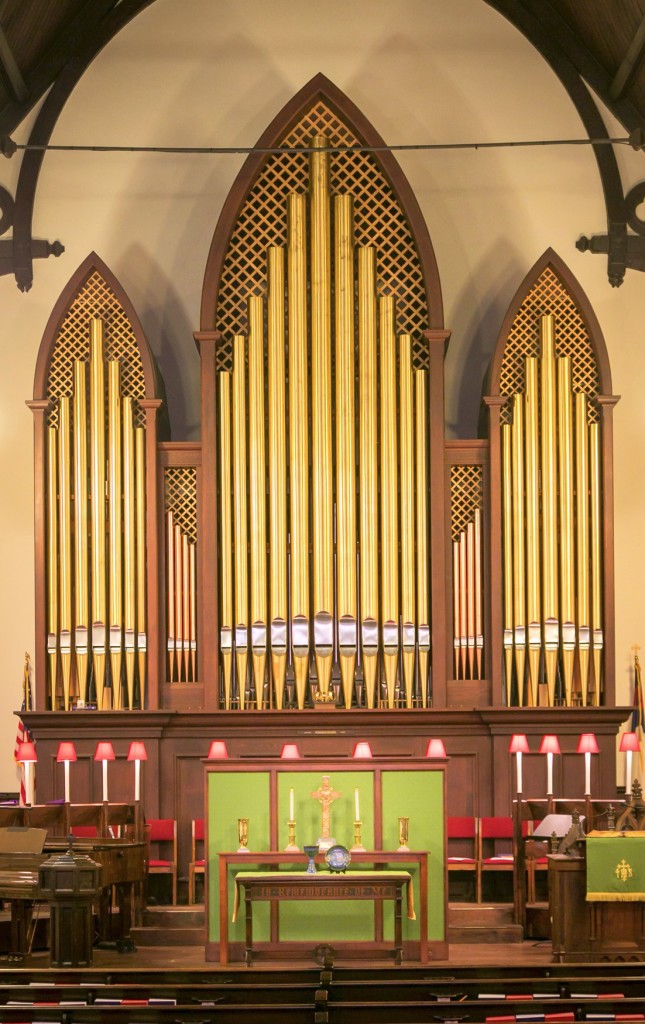
After years of investigation a decision was reached concerning replacement of the failing Allen organ. The Rieger-Kloss company of Czechoslovakia custom-designed and built the magnificent pipe organ which now enhances all the music of the church and enables Kanawha Church to present eminent organists from across the country in concert. The congregation came together to carry the pipes and other parts from the tractor-trailers at the front of the church into the sanctuary and the fellowship hail, where organ parts were almost wall-to-wall. After some weeks of watching the organ take shape in the sanctuary, the congregation saw the completed instrument dedicated in late May, 1995. New choir robes were purchased and the old robes were given to Bishop Simeon of Burundi. “Renewal” hymnals (to supplement The Presbyterian Hymnal) and Contemporary English Version pew Bibles were purchased.
Various building renovations have been carried out in the 1990s: the bell tower and bell were cleaned and repaired; carpet was installed in hallways and classrooms; the parlor, nursery, kindergarten, and library were completely redecorated and equipped. The stained glass windows were cleaned, and repairs were made where required: modifications were made to preserve and protect them.
The Reverend Todd Baucum joined Kanawha United Presbyterian Church in 1995. During his tenure, we saw significant growth in the number of children and families in our church. Christian Education Director Alicia Platz (2000-2002) reinvigorated many children’s programs, including vacation Bible school, overnight campouts, picnics, sleepovers at the church, and Sunday School for all ages. Music Director Ron Neal also renewed the children’s choir, and they now present two delightful musicals each year. An acolyte program was begun in 1996, which enabled young people to have an active role in the worship service.
Food and fellowship play a large part in the life of Kanawha Church, with an annual picnic at a local park, congregational dinners, Sunday after-service brunches and picnics at the church, coffee hour before and after Sunday services, and receptions on special occasions.
Congregational retreats at Bluestone Conference Center in the beautiful West Virginia mountains have nurtured the “church family” feel of Kanawha Church and have brought forth meaningful discussions and new ideas. The annual Ladies’ Tea (complete with hats, wild and/or wonderful!) is a delightful event for all ladies from the very young to the matriarch. “Fellowshipping” is not all play: there are several work parties annually, to clean or paint inside, and to dig, weed, plant, trim, and rake outside.
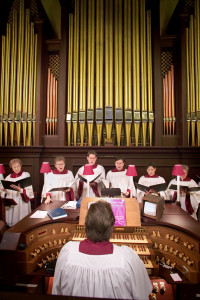
Music has long been of primary importance at Kanawha Church, and this tradition continues. Ron Neal and the choir maintain a high standard of excellence and offer a broad spectrum of choral presentation, from the Bach “Magnificat” and Vivaldi “Gloria”, Ralph Vaughn Williams’ “Five Mystical Songs” and Benjamin Britten’s “Rejoice in the Lamb”, to Natalie Sleeth’s “Joy in the Morning”, Andre Crouch’s spiritual “Going to See the King”, and Geron Davis’ “On Holy Ground”. The choir is blessed with excellent solo voices as well as able choristers and “choral Scholars”, talented young singers from local high schools, who receive both experience and a stipend for their service. Local instrumental musicians from the West Virginia Symphony frequently join with the choir for special presentations, and the Montclair String Quartet presented its concerts in Kanawha Church’s sanctuary. Numerous concerts by solo artists are sponsored by the church and presented in the sanctuary. In 2002 the Music and Arts Committee produced a complete opera, Puccini’s “La Boehme,” in the sanctuary. Mozart’s “Cosi Fan Tutte” was presented in January 2003 at a larger venue, since the church could not accommodate all the people who wanted to attend. Kanawha Church also has a handbell choir which plays frequently and is a congregational favorite. And there is always the magnificent pipe organ, its capabilities utilized to the fullest by master organist Ron Neal, lifting spirits visually as well as with its sound.
In September 2001, Todd Baucum left Kanawha Church to become pastor at another church, after six years. In 2002, Dionne Canterbury was hired as Christian Education Director. With an impressive background in education and music, she has maintained and strengthened our educational programs, for both children and adults.
In October 2003, the Reverend John R. Davis accepted our call and served until 2009, when he accepted a call to another church.
In 2006 Chris Rogillio became full time Director of Christian Education, bringing two decades of experience, along with endless energy and creativity. While Chris has enlarged learning opportunities for both children and adults within Kanawha Church, outreach and social concern have also been greatly enhanced through her efforts The youth of the church are involved in hands-on service to the community. One of the “most fun” projects for all concerned was “The Great Potato Drop”, when the back parking lot was covered by a mountain of 40,000 pounds of sweet potatoes! The word was spread about the potato bonanza, all ages joined in the bagging , and all day long people came to receive the free potatoes. Some were individuals who needed a hand with feeding their families. Others came from considerable distances, in pickup trucks, to carry loads to food banks.
Vacation Bible School has become a community event, with many children from beyond our congregation taking part. While some events are planned “just for fun” (movies, sleepovers, baseball games), many more involve the young people of the church in caring for people in the community.
A short children’s sermon is presented every Sunday, after which the younger children withdraw for Bible stories and crafts. Once a month the children (and the adults!) are treated to a puppet presentation which teaches as it entertains.
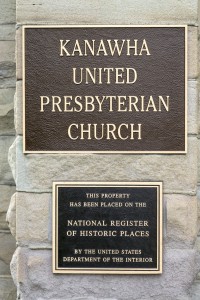 Kanawha Church’s beautiful building is in the National Register of Historic Buildings, and while no significant changes have been made to the original building, some improvements have been made to increase accessibility. In the education building (dedicated in1954) several major replacements and repairs have been carried out. Windows were replaced to conserve heat and cooling, doors were replaced for facility and security, accessibility was implemented, and kitchen equipment was upgraded or replaced. Major roof repair was also done.
Kanawha Church’s beautiful building is in the National Register of Historic Buildings, and while no significant changes have been made to the original building, some improvements have been made to increase accessibility. In the education building (dedicated in1954) several major replacements and repairs have been carried out. Windows were replaced to conserve heat and cooling, doors were replaced for facility and security, accessibility was implemented, and kitchen equipment was upgraded or replaced. Major roof repair was also done.
A number of special services highlight the church year at Kanawha Church. The candlelight service on Christmas Eve features special music and the total darkening of the church before the single pinpoint of candle flame, passed from one to another throughout the sanctuary, brings light to the whole congregation, as Christ brings light to the world. This service is held in the early evening in order to accommodate families with young children. On Maundy Thursday there is a Christian Seder Celebration, and on Good Friday the moving “Stripping of the Altar” reminds one of the bleakness of that Friday. For Thanksgiving, the Sunday School sponsors the “Fruiting of the Table”, when members bring bags of apples, potatoes, oranges, and other fruits and vegetables, and place them in the front of the sanctuary: They are then taken to Manna Meal, which feeds needy people every day.
Within the walls of Kanawha Church, members are generous in response to the Centsibility Offering, the Mitten Tree, Operation Christmas Child, Adopt-a-Family, and the Heifer Fund. Presbyterian Women support the National Presbyterian Women’s mission projects through the Thank Offering, the Birthday Offering, and the Fellowship of the lost coin. Reaching beyond our sanctuary, members participate in Habitat for Humanity, both with saws and hammers and by preparing lunches for the workers. Once a month a church service is provided for residents of Quarry Manor, a local assisted living facility, with a spiritual message, hymn singing, communion quarterly, and visiting with residents who attend. Several members regularly visit Piedmont School to help out in the library and occasionally visit and have fun with the children in the lunchroom. Oakwood Terrace, a Presbyterian-founded housing complex for families needing assistance, is treated to a Halloween party and a Christmas event with gifts for the children and turkeys for family dinners, and other activities such as swimming pool parties for the kids. In the fall of 2010 a free community dinner of hot dogs and all appropriate sides was served to all comers from the neighboring community who needed a hot meal. It was received with grace and gratitude by those we served, and members who participated felt it to have been such a blessing that another dinner was served in November, with turkey and all the fixings. About 100 people were served, and a good number of those came back for seconds, and some for thirds. We hope to repeat this successful outreach.
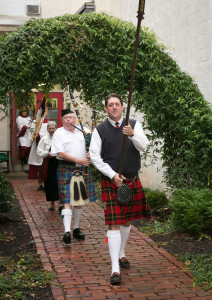
An undertaking which has attracted much community interest and participation is a celebration of our Scottish heritage, the “Kirkin o’ the Tartan”, which Kanawha Church began in 2006. With skirling bagpipes, Scottish dancers, kilts and plaids in abundance, Scottish foods, a native Scot in the pulpit, and traditional blessing of the tartans, many beyond our congregation, whether of Scottish descent or not, have joined in the festivities.
Other special activities through the year are the PALS (Presbyterians at Leisure) luncheons; the July barbecue; the “souper bowl” produced by the youth in February, with proceeds to Manna Meal. The middle school and high school youth serve “hands on” at Sojourners’ Shelter, Covenant House, Manna Meals, and Oakwood Terrace, serving food and providing entertainment. In 2010 six young people attended Triennium at Perdue University. Many of the children attend age-appropriate summer camp sessions at Bluestone, and both children and adults travel to Bluestone for retreats tailored to their ages and responsibilities.
We have been greatly blessed in the past, we are blessed now, and we look forward to the blessings of the next two hundred years!
Compiled by: Nancy Wallace
December 2010
